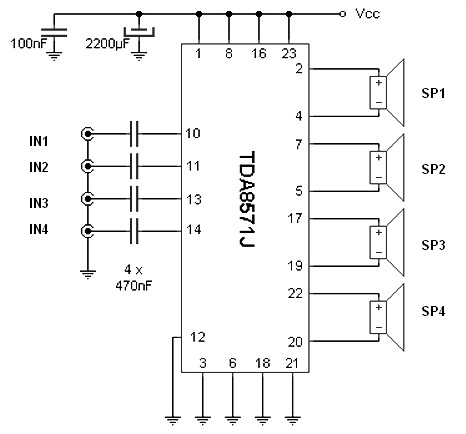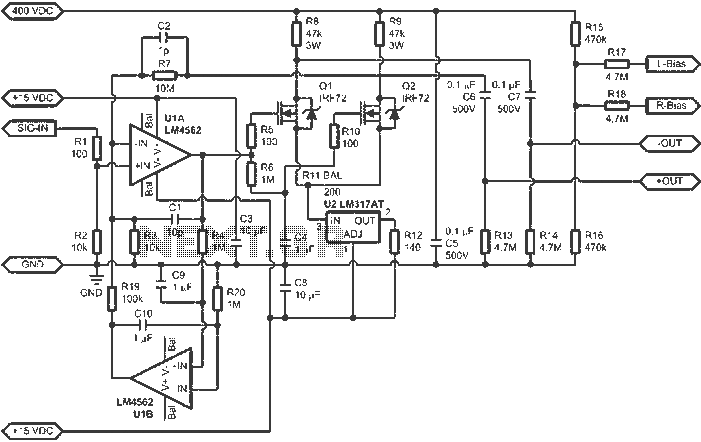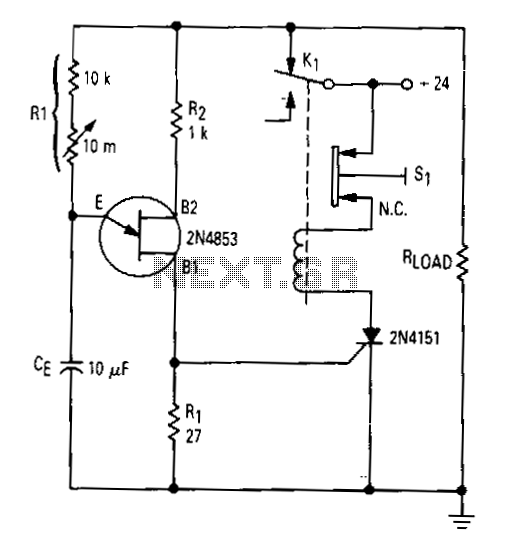
Very Simple Bench Amplifier
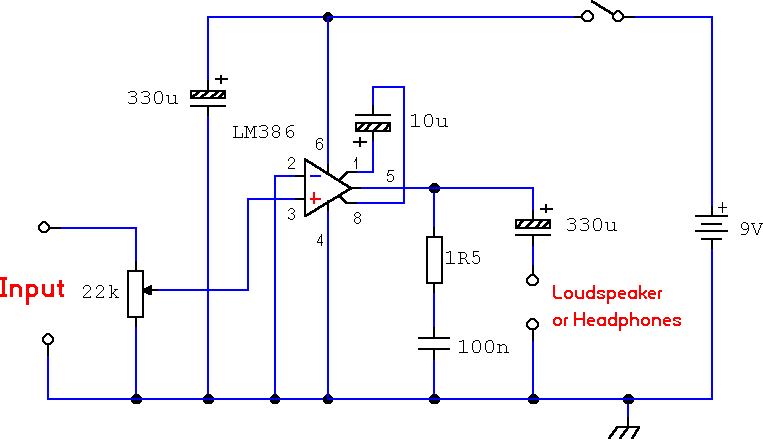
A compact 325mW amplifier with a voltage gain of 200, suitable for use as a bench amplifier, signal tracer, or to amplify the output from personal radios. The circuit utilizes the National Semiconductor LM386 amplifier. In the schematic, the LM386 operates as a complete non-inverting amplifier with a voltage gain of x200. A PDF datasheet can be downloaded from the National Semiconductor website. The IC is available in an 8-pin DIL package with several versions: the LM386N-1, which provides 325mW output into an 8-ohm load; the LM386N-3, which delivers 700mW output; and the LM386N-4, which offers 1000mW output. All versions are compatible with this circuit. The gain of the LM386 can be adjusted by a capacitor connected across pins 1 and 8. With the 10µF capacitor shown, the voltage gain is 200; omitting this capacitor reduces the gain to 20. The IC operates within a voltage range of 4 to 12 volts DC, with 12 volts being the maximum recommended supply voltage. The internal input impedance of the amplifier is 50kΩ, which is shunted with a 22kΩ logarithmic potentiometer, resulting in a lower input impedance of approximately 15kΩ in this configuration. The input is DC coupled, necessitating caution to avoid amplifying any DC from the preceding circuit, as this could potentially damage the loudspeaker. A coupling capacitor may be included in series with the 22kΩ control to mitigate this risk.
The LM386 amplifier circuit is designed for versatility in various applications, including audio amplification for personal radios and testing equipment. The choice of the LM386 integrated circuit allows for a compact design with efficient power consumption. The amplifier's voltage gain can be tailored to specific requirements by adjusting the feedback capacitor, enabling users to optimize performance based on the application.
The circuit's input configuration is critical for ensuring that only AC signals are amplified. The DC coupling of the input can lead to undesirable outcomes if DC offsets are present, thus the addition of a coupling capacitor is advisable to block any DC component. This capacitor should be selected based on the expected frequency range of the input signal to ensure minimal signal distortion while maintaining the desired frequency response.
The use of a logarithmic potentiometer for input impedance adjustment allows for fine-tuning of the amplifier's sensitivity, making it suitable for a range of signal levels. The selection of the appropriate version of the LM386 IC is essential, depending on the required output power and load impedance, ensuring that the amplifier can drive the intended load effectively without distortion or clipping.
Overall, this LM386-based amplifier circuit offers a robust solution for audio amplification needs, with the flexibility to adapt to various input conditions and output requirements, making it an excellent choice for both hobbyists and professionals in the field of electronics.A small 325mW amplifier with a voltage gain of 200 that can be used as a bench amplifier, signal tracer or used to amplify the output from personal radios, etc. The circuit is based on the National Semiconductor LM386 amplifier. In the diagram above, the LM386 forms a complete non-inverting amplifier with voltage gain of x200. A datasheet in PDF f ormat can be downloaded from the National Semiconductor website. The IC is available in an 8 pin DIL package and several versions are available; the LM386N-1 which has 325mW output into an 8 ohm load, the Lm386N-3 which has 700mW output and the LM386N-4 which offers 1000mW output. all versions work in this circuit. The gain of the Lm386 can be controlled by the capacitor across pins 1 and 8. With the 10u cap shown above, voltage gain is 200, omitting this capacitor and the gain of the amplifier is 20.
The IC works from 4 to 12Volts DC, 12Volt being the maximum recommended value. The internal input impedance of the amplifier is 50K, this is shunted with a 22k log potentiometer so input impedance in this circuit will be lower at about 15k. The input is DC coupled so care must be taken not to amplify any DC from the preceeding circuit, otherwise the loudspeaker may be damaged.
A coupling capacitor may included in series with the 22k control to prevent this from happening. 🔗 External reference
The LM386 amplifier circuit is designed for versatility in various applications, including audio amplification for personal radios and testing equipment. The choice of the LM386 integrated circuit allows for a compact design with efficient power consumption. The amplifier's voltage gain can be tailored to specific requirements by adjusting the feedback capacitor, enabling users to optimize performance based on the application.
The circuit's input configuration is critical for ensuring that only AC signals are amplified. The DC coupling of the input can lead to undesirable outcomes if DC offsets are present, thus the addition of a coupling capacitor is advisable to block any DC component. This capacitor should be selected based on the expected frequency range of the input signal to ensure minimal signal distortion while maintaining the desired frequency response.
The use of a logarithmic potentiometer for input impedance adjustment allows for fine-tuning of the amplifier's sensitivity, making it suitable for a range of signal levels. The selection of the appropriate version of the LM386 IC is essential, depending on the required output power and load impedance, ensuring that the amplifier can drive the intended load effectively without distortion or clipping.
Overall, this LM386-based amplifier circuit offers a robust solution for audio amplification needs, with the flexibility to adapt to various input conditions and output requirements, making it an excellent choice for both hobbyists and professionals in the field of electronics.A small 325mW amplifier with a voltage gain of 200 that can be used as a bench amplifier, signal tracer or used to amplify the output from personal radios, etc. The circuit is based on the National Semiconductor LM386 amplifier. In the diagram above, the LM386 forms a complete non-inverting amplifier with voltage gain of x200. A datasheet in PDF f ormat can be downloaded from the National Semiconductor website. The IC is available in an 8 pin DIL package and several versions are available; the LM386N-1 which has 325mW output into an 8 ohm load, the Lm386N-3 which has 700mW output and the LM386N-4 which offers 1000mW output. all versions work in this circuit. The gain of the Lm386 can be controlled by the capacitor across pins 1 and 8. With the 10u cap shown above, voltage gain is 200, omitting this capacitor and the gain of the amplifier is 20.
The IC works from 4 to 12Volts DC, 12Volt being the maximum recommended value. The internal input impedance of the amplifier is 50K, this is shunted with a 22k log potentiometer so input impedance in this circuit will be lower at about 15k. The input is DC coupled so care must be taken not to amplify any DC from the preceeding circuit, otherwise the loudspeaker may be damaged.
A coupling capacitor may included in series with the 22k control to prevent this from happening. 🔗 External reference
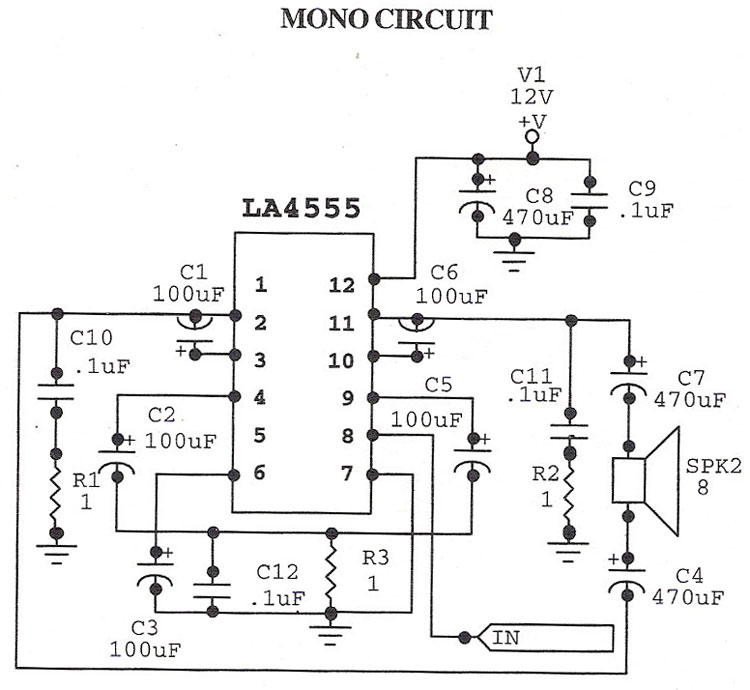
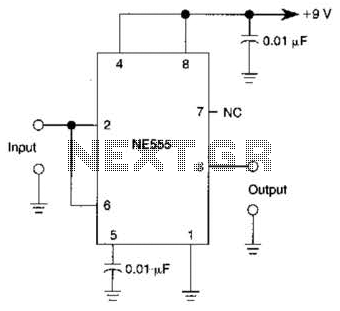
%2BCircuit%2Bdiagram%2Busing%2BCD4047%2Band%2BIRFZ44%2Bpower%2BMOSFET.png)
